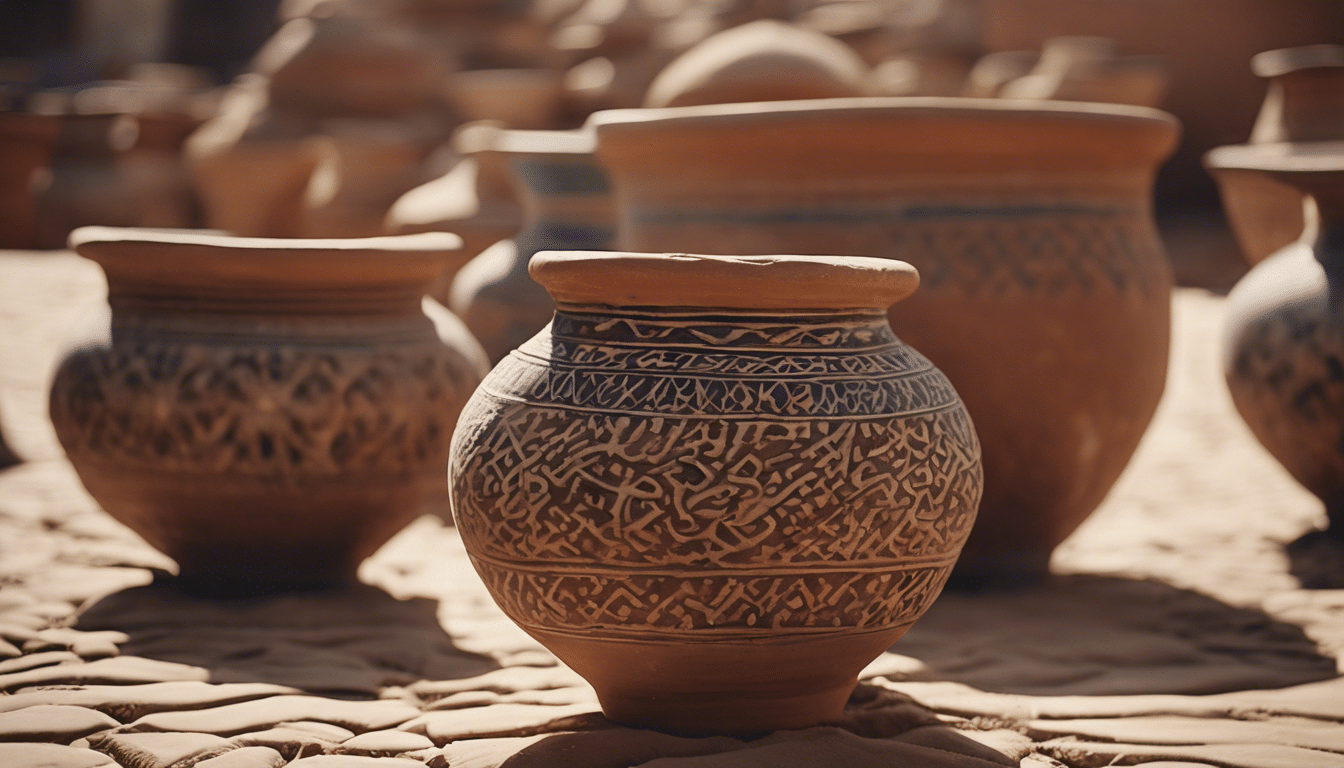Pottery represents not only functional art but also a profound reflection of human creativity and cultural expression that has developed over millennia, serving as a cornerstone of traditional crafts across global cultures.
From its ancient origins to the diverse pottery techniques observed across various continents, pottery stands as a testament to the craftsmanship of numerous global cultures.
This examination delves into the origins and evolution of pottery, emphasizing traditional methods and pottery styles that are distinct to Africa, Asia, Europe, Native American communities, and South America.
Additionally, it investigates the cultural significance and social functions of pottery within cultural practices and daily life, demonstrating why this time-honored craft continues to engage and inspire individuals today.
The History of Pottery
.jpg_00.jpeg)
The history of pottery extends over thousands of years, embodying the intricate relationship between human civilization and diverse global cultures, and highlighting the evolution of art forms and pottery traditions.
From the earliest earthenware utilized for practical applications to the elaborate decorative pottery observed today, the evolution of pottery techniques and pottery styles has been shaped by environmental factors, social structures, and cultural identities.
Ancient pottery artifacts offer valuable insights into the daily lives, rituals, and craftsmanship of various communities, underscoring the significance of pottery as both functional pottery and artistic expression.
This historical journey emphasizes the importance of preserving pottery traditions and understanding their cultural heritage and artistic techniques.
How Did Pottery Begin?
Pottery originated as a fundamental necessity for early human societies, arising from the requirement for durable containers to store food and water, highlighting its role in pottery as cultural identity. This need prompted the development of various pottery techniques utilizing local materials, predominantly the types of clay that were readily available in their environment, including hand-building and wheel throwing methods.
These ancient pottery creations served not only practical functions but also embodied the cultural and artistic expressions of their creators, showcasing pottery as a medium for storytelling and cultural preservation. Techniques such as coiling, slab building, and hand-building were employed to shape the clay, while the incorporation of tempering materials, such as sand or crushed shells, enhanced the durability and longevity of the finished products.
As societies progressed, their approach to pottery also evolved, integrating decorative elements and advanced firing methods that improved both the strength and aesthetic appeal of functional pottery. This foundational work laid the groundwork for future advancements, leading to increasingly sophisticated pottery styles and a greater diversity of shapes and functions.
How Did Pottery Evolve Over Time?
As civilizations progressed, pottery underwent significant evolution, marked by innovations in techniques such as firing methods and glazing. These advancements not only enhanced the functionality of ceramic art but also its aesthetic appeal, reflecting the cultural values and artistic expressions of their respective eras.
Throughout the centuries, artisans began to explore a variety of firing techniques, including pit firing and kiln firing, which markedly improved the durability and finish of their creations. The intricate glazing methods that emerged during the Middle Ages introduced vibrant colors and textures and conferred protective qualities upon the pottery, demonstrating the evolution of decorative techniques and ceramic glazes.
Distinct regional pottery traditions developed, each showcasing unique styles and pottery motifs influenced by local resources and cultural contexts. From the delicate porcelain of China to the rustic earthenware of the Mediterranean, these innovations underscore the dynamic interplay between technology and art in pottery, illustrating how it has continuously adapted to fulfill the needs and preferences of diverse societies.
Traditional Pottery Across Different Cultures
Traditional pottery represents a crucial connection to the cultural heritage of communities around the globe, emphasizing the importance of heritage crafts and cultural preservation. It highlights the diverse pottery techniques specific to various regions, which are informed by local materials, artistic expressions, and the functional roles these items play in daily life.
Each piece unveils the cultural significance inherent in its creation, providing insight into the values and traditions of the communities that produce them, highlighting the role of pottery in rituals and community workshops.
1. African Pottery Techniques
African pottery techniques encompass a diverse array of indigenous practices, wherein artisans skillfully create distinctive pottery shapes and decorative patterns that often reflect community practices and cultural narratives, while adhering to time-honored traditions, showcasing indigenous art and craft preservation.
These methodologies include hand-building techniques such as coiling, pinching, and slab construction, which facilitate individual expression and creativity. Surface decoration holds equal importance; motifs and designs often symbolize status, ancestry, or spiritual beliefs and are applied through various techniques, including burnishing, painting, or carving, demonstrating the significance of pottery aesthetics.
Firing practices within these communities also exhibit considerable variation, with some employing open-fire methods while others utilize kilns to achieve different textures and colors. Pottery in these cultures serves not only functional purposes, such as cooking or storage, but also functions as a medium for storytelling and historical preservation, thereby reinforcing its cultural significance within the community, reflecting the role of pottery in everyday life and cultural exchange.
2. Asian Pottery Techniques
Asian pottery techniques are distinguished by their exceptional craftsmanship, particularly in the creation of porcelain and ceramic art, emphasizing traditional pottery methods and artistic expression. These techniques employ sophisticated glazing methods and ceramic glazes that enable artisans to achieve intricate designs and vibrant colors, thereby expressing their artistic vision and pottery symbolism.
Throughout the continent, artisans utilize unique methodologies that reflect their cultural heritage, drawing upon local materials such as clay sourced from specific regions.
For example, Japanese Raku pottery is renowned for its unpredictable patterns, which result from a rapid firing process.
In contrast, pieces from the Chinese Ming dynasty exemplify the pinnacle of craftsmanship, characterized by precise blue-and-white underglaze painting.
Korean celadon is notable for its iconic jade-green glaze, highlighting the interplay between form and color. Each regional style not only demonstrates technical expertise but also embodies deeply rooted traditions, allowing potters to convey narratives and emotions through their creations. As a result, each piece serves as a true representation of the artisan’s artistic journey.
3. European Pottery Techniques
.jpg_01.jpeg)
European pottery techniques have undergone significant evolution over centuries, driven by cultural exchange and innovation. This evolution has resulted in the emergence of distinct styles, such as stoneware and fine earthenware, each characterized by unique aesthetic qualities and the high level of craftsmanship involved in their production.
The history of European pottery presents a rich tapestry of artistic expression, ranging from the intricate hand-formed vessels of ancient Rome to the delicate porcelain developed in the 18th century.
Notable techniques, such as salt glazing, which originated in Germany, along with the subsequent influence of Delftware in the Netherlands, exemplify the ingenuity of artisans committed to refining their craft.
The Renaissance period marked a further advancement in pottery, as increased patronage fostered experimentation in form and decoration. These historical milestones not only underscore the development of pottery as an esteemed art form but also reflect the societal and cultural transformations that have shaped the aesthetic values of each respective era.
4. Native American Pottery Techniques
Native American pottery techniques are fundamentally rooted in cultural traditions, emphasizing the creation of functional pottery that utilizes local clay types and incorporates unique motifs that convey stories and cultural significance. These pottery pieces are often employed in rituals and community practices.
The methods employed not only reflect the artistic expression of various tribes but also fulfill practical purposes, such as storage, cooking, and ceremonial applications. Distinct tribes, such as the Pueblo and Hopi, demonstrate unique firing and glazing techniques that vividly illustrate their narratives through intricate designs.
For example, the swirling patterns present in Pueblo pottery may symbolize elements of the natural world, while Hopi pottery frequently includes storytelling elements that encapsulate ancestral heritage. By exploring these diverse approaches to pottery-making, one can gain valuable insights into the profound connections between art, identity, and spirituality within Native American cultures.
5. South American Pottery Techniques
South American pottery techniques exemplify vibrant folk pottery traditions, distinguished by colorful patterns and artistic methods that reflect the diverse cultural identities and community art practices of the region.
These techniques exhibit significant variation among different cultures, with each group incorporating its unique beliefs and historical narratives into their creations. For example, Indigenous artisans frequently employ coiling and slab building methods to produce both functional and decorative pieces, while intricate painting and engraving techniques enhance these items, showcasing local flora and fauna.
The vivid colors found in their pottery patterns often symbolize various elements of nature and spirituality, thereby deepening the connection between the art and the community’s identity.
Pottery serves not only as a medium for artistic expression but also as an essential means of storytelling, preserving traditions, and reinforcing communal bonds within society, exemplifying its role as Folk art and in community art.
The Techniques Behind Traditional Pottery and Ceramics
The techniques employed in traditional pottery encompass a diverse range of methods, including hand-building, wheel-throwing, and various firing techniques. These pottery techniques have been developed over centuries and across different cultures, reflecting a rich history of innovation and adaptation.
Each of these methods contributes significantly to the final clay body and plays a crucial role in shaping the unique aesthetics of the ceramic art produced, which often includes elements of surface decoration and pottery motifs.
1. Handbuilding Techniques in Pottery
Hand-building techniques in pottery involve the manipulation of clay into various forms without the use of a potter’s wheel. This approach facilitates a diverse range of sculptural pottery and distinctive forms that emphasize the artisan’s craftsmanship skills.
Among these techniques, the pinch method provides a tactile experience, enabling even novice potters to create organic shapes by pinching and thinning the clay with their fingers. In contrast, the coil method entails rolling clay into elongated strands, which can be stacked to form vessels or more abstract sculptures, thereby showcasing the potter’s ability to create textures and designs that reflect their individuality.
Slab construction allows for the cutting of flat pieces of clay, which can be assembled to construct functional items as well as intricate decorative pieces. This technique offers artisans the opportunity to explore geometric forms and layered aesthetics.
Each of these methods fosters creativity and enables the potter to articulate their artistic vision while refining their craftsmanship skills.
2. Wheel Throwing Techniques
Wheel throwing techniques necessitate precision and skill, allowing potters to shape clay on a spinning wheel. This process facilitates the creation of consistent pottery shapes and refined forms that exemplify the potter’s craftsmanship, often seen in artisan pottery and regional pottery styles.
The process commences with the preparation of the clay, which involves wedging to eliminate air bubbles and ensure an even consistency. Once the clay is centered on the wheel, the potter applies pressure with their hands, gradually forming various shapes, such as bowls or vases.
Each stage of the process, including opening and pulling up the walls, requires careful attention to maintain balance and symmetry.
This technique provides creative freedom while ensuring structural integrity, making it an essential skill for any potter. Mastering wheel throwing not only enhances artistic expression but also improves the durability and functionality of the finished pieces, thereby elevating the overall quality of pottery craftsmanship.
3. Coil and Pinch Techniques in Pottery
.jpg_10.jpeg)
Coil and pinch techniques are essential pottery methods that enable artists to produce both functional and decorative pieces, utilizing the inherent properties of clay to convey artistic individuality in their pottery forms.
These techniques have been practiced for thousands of years, originating from ancient civilizations, including those in Africa and Asia, where early potters first explored shaping this malleable material with their hands.
The coil method entails rolling long strands of clay that are layered and blended together, facilitating the creation of larger and more intricate vessels. This method is a testament to the craft techniques and creative expression found in historical pottery. It not only enhances the strength of the finished product but also allows for the incorporation of unique textures and patterns, thereby showcasing the artisan’s creative expression.
Conversely, the pinch technique emphasizes simplicity, as it involves the manipulation of a single lump of clay using the fingers to craft bowls or sculptures. This approach highlights the personal touch and spontaneity inherent in artistic expression.
Collectively, these pottery methods not only honor craftsmanship but also establish a connection between contemporary artists and their rich cultural heritage.
4. Slipcasting Techniques
Slipcasting techniques involve the process of pouring liquid clay, commonly referred to as slip, into molds to create intricate shapes and designs. This approach facilitates efficient production and ensures consistency in ceramic art, while also allowing for creative experimentation.
This method is particularly esteemed within the pottery community due to its capacity to replicate complex forms and fine details that may be challenging to achieve through traditional hand-building techniques.
By utilizing various types of plaster molds, artists can produce both functional items, such as dinnerware and vases, as well as decorative pottery pieces that serve as visually appealing centerpieces.
The inherent versatility of slipcasting also enables the incorporation of different glazes and surface treatments, thereby expanding the artist’s ability to express their creativity while maintaining a high level of reproducibility in their work.
5. Glazing Techniques
Glazing techniques are essential in enhancing the aesthetic appeal of pottery. They enable potters to apply various colors and surface decorations that ultimately define the appearance and sensory qualities of ceramic pieces, while also providing functional advantages such as increased durability.
Each glazing method—whether dipping, spraying, or brushing—offers distinct effects, transforming the surface into an engaging canvas. The vibrant colors achieved through overglazes contrast beautifully with the subtle tonal variations produced by underglazes, with both methods contributing significantly to the artistic expression found in ceramics.
Additionally, techniques such as sgraffito or glaze layering can create intricate designs that capture attention and inspire discussion. By thoughtfully selecting and manipulating these glazing techniques, artisans not only demonstrate their creativity but also infuse each piece with unique character, thereby enriching the viewer’s experience and appreciation of this art form.
The Importance of Traditional Pottery and Ceramics in Different Cultures
Traditional pottery and ceramics hold significant importance across various cultures, functioning not only as utilitarian objects for daily use but also as a medium for artistic expression and cultural identity.
This art form effectively reflects cultural values, identity, and communal practices.
1. Functional Use
Functional pottery plays a crucial role in everyday life, providing utilitarian shapes specifically designed for cooking, serving, and storage. These forms not only address the practical needs of communities but also reflect their daily practices.
Across various cultures, pottery adapts to the rituals and routines of the people. In numerous households, clay pots are utilized for simmering stews, while intricately designed bowls serve as vessels for communal meals, embodying the spirit of togetherness. Cups and pitchers, often embellished with local motifs, are not merely for serving beverages; they also play a significant role in traditional ceremonies, reinforcing cultural narratives.
Furthermore, storage jars designed for preserving grains highlight agricultural practices and seasonal storage requirements, illustrating how this art form seamlessly integrates functionality with cultural identity.
Ultimately, functional pottery forms a vital backbone to communal life and celebrations.
2. Cultural Significance
The cultural significance of pottery transcends its physical form, as many pieces are imbued with symbolism that conveys the stories, traditions, and spiritual beliefs of the communities that produce them.
These artistic expressions stand as a testament to the craftsmanship of skilled artisans who have transmitted their techniques through generations. Each shape and glaze reflects the unique identity of its creator, drawing upon ancestral practices and local resources.
For example, Indigenous pottery frequently incorporates motifs that represent nature and cosmology, thereby forging a connection between the artist and their environment. This style is often seen in Native American pottery as well. In contrast, Eastern traditions may emphasize concepts of harmony and balance through intricate designs.
Through these diverse techniques and thematic representations, pottery not only enhances cultural heritage but also cultivates a deeper appreciation for the narratives that shape human experiences and societal values.
3. Artistic Expression and Pottery Aesthetics
.jpg_11.jpeg)
Artistic expression in pottery encompasses the aesthetics, motifs, and patterns employed by artisans to convey cultural narratives and personal creativity, reflecting a rich tapestry of ideas and influences shaped by cultural exchange over generations.
These design elements not only underscore the individual potter’s skills and imagination but also function as a bridge connecting diverse traditions and techniques. For example, the vibrant glazes and intricate carvings characteristic of Japanese Raku pottery reveal a profound appreciation for nature, while Indigenous pottery often showcases storytelling through symbolic forms and earthy colors.
The interplay of geometric patterns and textures can evoke a sense of cultural identity, enabling artists to communicate shared histories while expanding the boundaries of their medium. Pottery aesthetics often draw from local materials and regional influences to create unique and meaningful designs.
Ultimately, such artistic choices in pottery enhance the functionality of ceramic pieces and invite dialogue about the vibrant cultural heritages that inspire them.
Frequently Asked Questions
What are some common techniques used in traditional pottery and ceramics across global cultures?
Some common techniques include hand-building, coiling, slab construction, and wheel throwing. These are often complemented by glazing and surface decoration techniques, which vary across different pottery traditions.
What is coiling and how is it used in traditional pottery?
Coiling is a technique where long ropes of clay are stacked and smoothed together to form the walls of a vessel. It is often used in traditional pottery to create larger, more complex shapes.
How is slab construction different from coiling in pottery techniques?
Slab construction involves rolling out sheets of clay and cutting them into specific shapes that are then joined together to create a vessel. This pottery technique is often used for creating flat or angular forms and involves careful craftsmanship. It has roots in various ancient civilizations and reflects the cultural heritage of pottery traditions around the world.
What role does the potter’s wheel play in traditional pottery techniques?
The potter’s wheel is a fundamental tool used in traditional pottery techniques, such as wheel throwing, to help shape and form vessels quickly and efficiently. It allows for precise control and symmetry in the final product, which is essential in both functional pottery and decorative pottery.
Are there any traditional pottery techniques that do not involve the use of a wheel?
Yes, there are several pottery techniques such as hand-building, where the potter uses only their hands and basic pottery tools to form the vessel, and pit firing, where the pottery is fired in a pit dug into the ground instead of a kiln. These methods highlight the community aspects of pottery workshops and the importance of using local materials.
How do traditional pottery techniques vary across different global cultures?
Traditional pottery techniques can vary greatly depending on the region and cultural influences. For example, Native American pottery often incorporates intricate designs and symbols as a form of artistic expression, while Japanese pottery often focuses on simplicity and minimalism. Furthermore, pottery techniques of Africa, Asian pottery, and European pottery each bring unique pottery styles, motifs, and artistic techniques that contribute to the rich tapestry of global cultures and the cultural significance of pottery.

My name is Bruno, I have been a writer for 5 years and I work with website creation. My goal is to provide true information to readers. In fact, on this site I write about cultures and traditions, which I have been passionate about since childhood.




